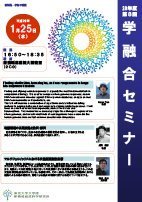AY2016 8th Gakuyugo Seminar
- Date&Time:
- Jan 25, 2017 16:50~18:35
- Venue:
- Large Lecture Room (2C0), New Frontier Science Bldg.

Finding similarities, homologies, and rearrangements in huge bio-sequence datasets
Professor Martin FrithFinding and aligning related sequences is arguably the most fundamental task in computational biology. It is used to: compare whole genome sequences, It is used to: compare whole genome sequences, search DNA from unknown microbes against DNA or protein databases, analyze ancient DNA from mammoths or Neanderthals, etc. This talk will describe a This talk will describe a combination of algorithmic and statistical-modelling methods to achieve both speed and accuracy in aligning related sequences. It will focus on a It will focus on a method to find rearrangements, such as inversions and translocations. It will focus on a method to find rearrangements, such as inversions and translocations.

Long-term changes in the geo-environment and disaster prevention/mitigation
Professor Toshihiko SugaiThrough case studies, we will show that in order to prevent natural disasters, it is important to reconstruct the long-term changes in the natural environment of the past and to understand the origins of the land.

Cross-correlated property response in multiferroics
Associate Professor Yusuke TokunagaA system in which several of the strong orders such as ferromagnetism, ferroelectricity, and ferroelasticity coexist is called a multiferroics. In such systems, there is often a coupling between multiple strong orders, resulting in a non-trivial response to external stimuli (external field) that is not conjugated. This is called the cross-correlated property response. In this lecture, as an example, I will introduce the research on the control of polarization by magnetic field and the control of magnetization by electric field in ferromagnetic ferroelectrics.
*The contents of this page were developed based on a machine translation.

